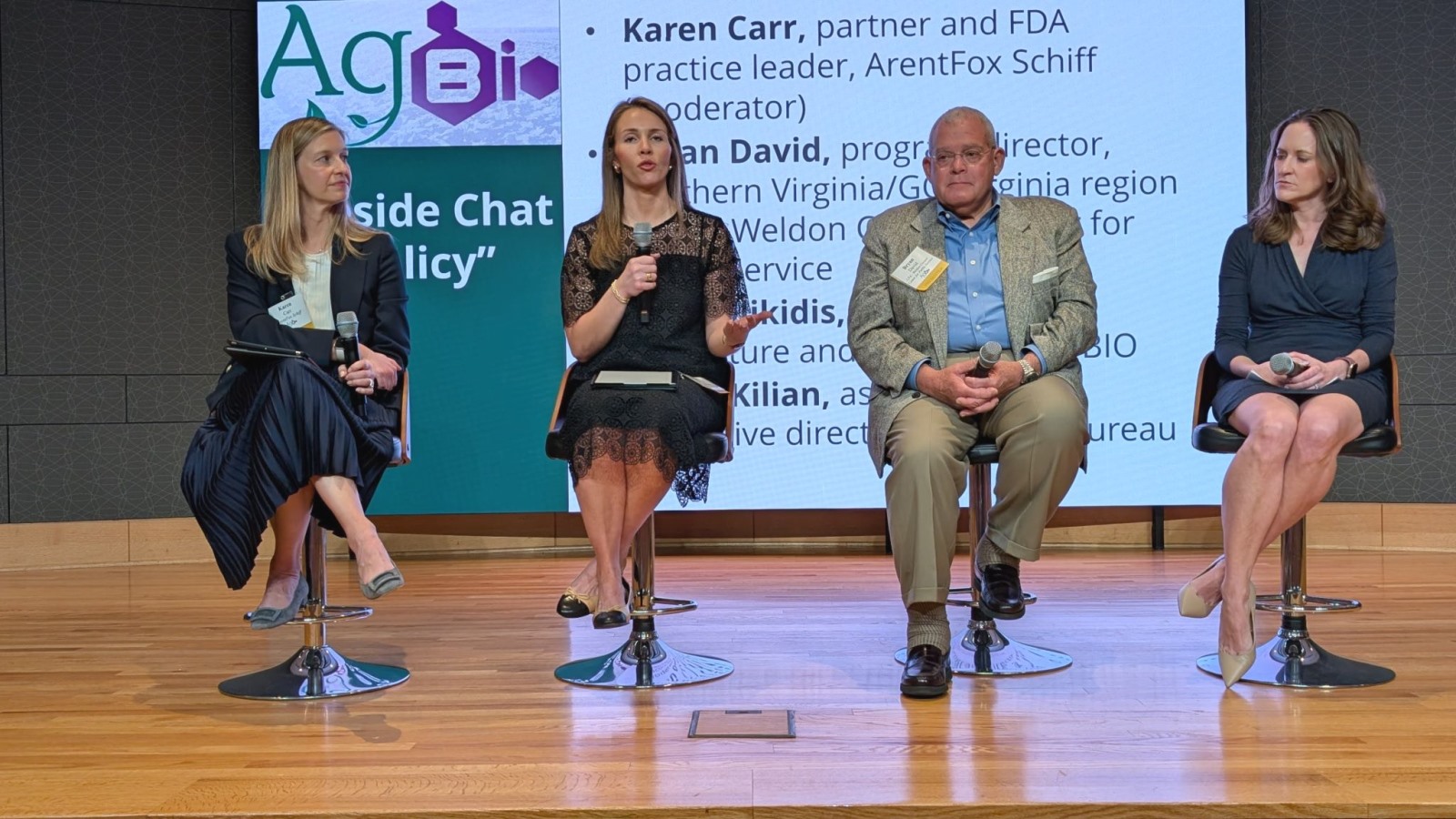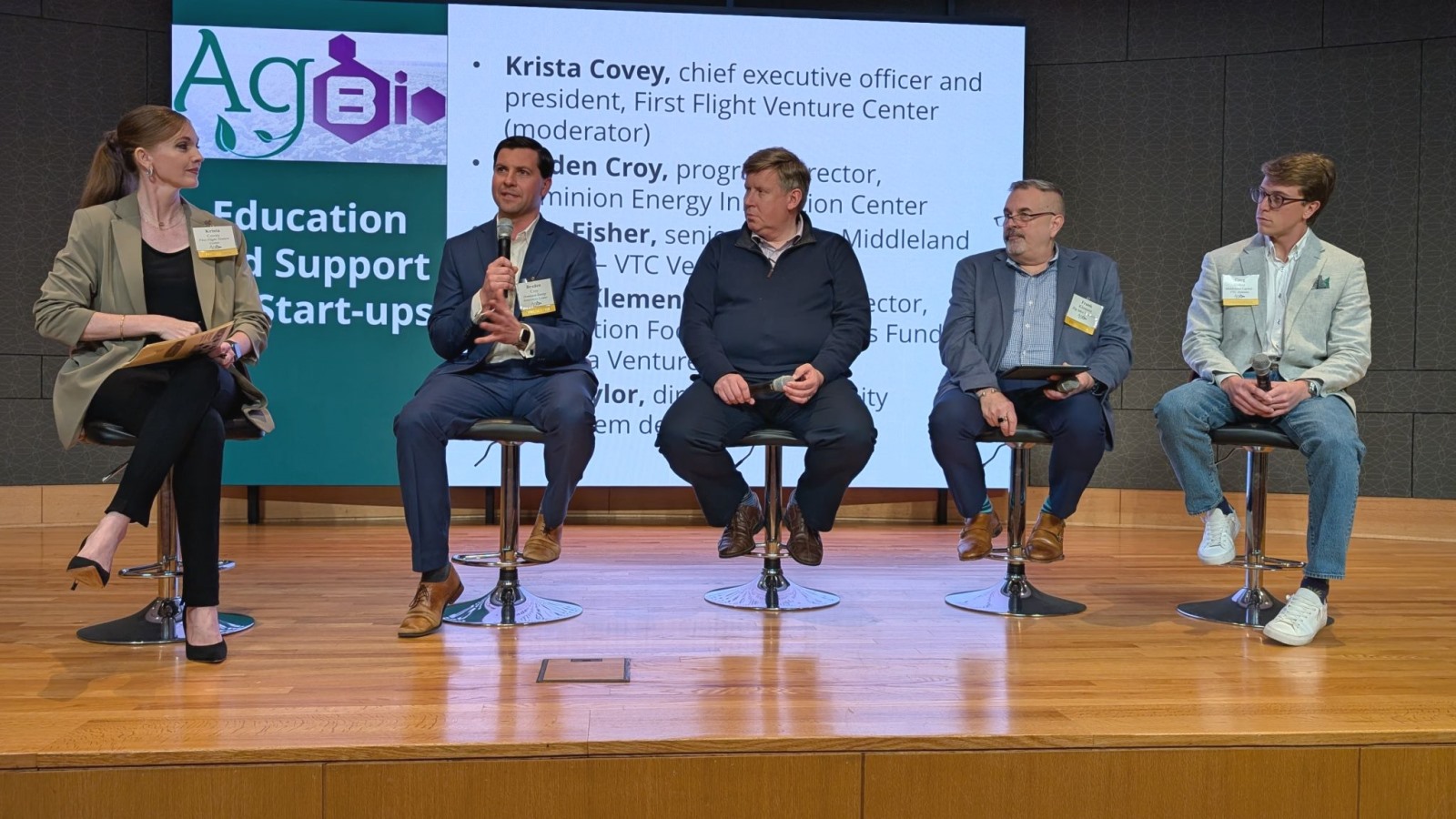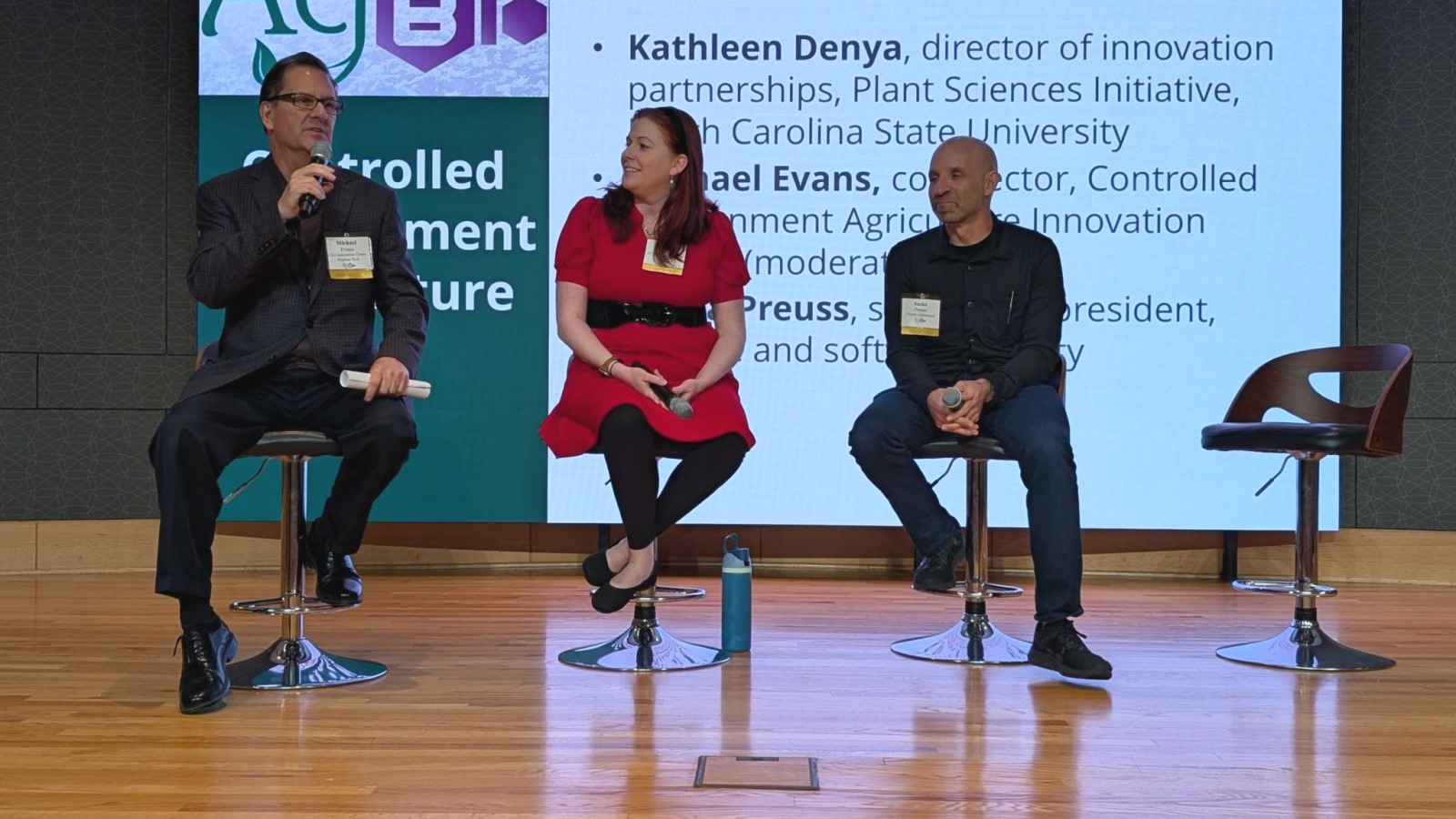AgBio 2025 brings North Carolina, Virginia together to explore agriculture, biotech
Life sciences organizations in North Carolina and Virginia came together at AgBio 2025 to explore the intersection between agriculture and biotechnology at the NC Biotechnology Center on Wednesday, April 9.
Hosted by NCLifeSci, Virginia Bio, the Institute for Advanced Learning and Research and NCBiotech, the event brought together more than 100 stakeholders to discuss the bioeconomy, public policy, intellectual property, support for start-ups and more.
Avantor was the event’s Premier Sponsor with the Virginia Innovation Partnership Corporation contributing as the Platinum Sponsor and CSC Leasing as the Gold Sponsor. Finnegan, the Institute for Advanced Learning and Research, Safety Partners, Smith Anderson, SU Group and the Virginia Department of Agriculture and Consumer Affairs all contributed as Silver Sponsors.
Panel 1: Policy Fireside Chat

The policy panel discussed the complex challenges and innovative solutions facing agricultural biotechnology, with panelists offering candid insights into transforming the agricultural landscape.
Karen Carr, partner and FDA practice leader at ArentFox Schiff, served as the moderator of a panel comprising
- Bryan David, program director, southern Virginia/GO Virginia region 3, UVA Weldon Cooper Center for Public Service;
- Beth Ellikidis, vice president, agriculture and environment, BIO; and
- Laura Kilian, associate state legislative director, NC Farm Bureau.
The discussion centered on the critical need for collaborative approaches to support farmers and advance agricultural technologies.
‘Farmers are really at a crisis right now,” Killian said. “They're also very resilient and that's why they have hope for the future and they're going to depend on folks like this in the room to give them the tools necessary."
Ellikidis highlighted the regulatory challenges facing the industry, noting that many agricultural biotech companies "have to go through three different agencies and those three agencies don't necessarily talk" to each other. This fragmented approach creates significant barriers for innovative technologies, making it difficult for smaller companies to bring new solutions to market, she said.
David talked about rural economic development, emphasizing the transformative potential of controlled-environment agriculture. He said that CEA represents a unique opportunity that plays to both the technological future and the agricultural legacy, creating a bridge between innovation and community traditions.
The panel identified several key strategies for moving forward.
Kilian introduced the NC Ag Leads project, which developed a strategic approach called HARVEST focusing on market access, talent pipeline and technology alignment. She challenged the audience to consider a fundamental question: "What part of the world are you trying to feed?"
Ellikidis highlighted a recent National Security Commission report that she said could be a game-changer and suggested a coordinating office to help startups navigate the complex regulatory landscape. She emphasized the industry's significant economic impact, noting that biotechnology contributes $210 billion in direct economic impact and supports 430,000 jobs across various industries.
David focused on innovative approaches to rural economic development, discussing a study that explores the potential of matching data centers with agricultural greenhouses to take advantage of the heat generated by the data centers to support agricultural production.
The panelists unanimously stressed the importance of collaboration. As Kilian put it, agriculture needs "somebody who can connect all these facets of the supply chain of industry and how everything in these rural communities works."
The discussion underscored a critical point: agricultural innovation is not just about technology but about supporting farmers, rural communities and the broader ecosystem of agricultural production. As Ellikis said, it's about ensuring that biotechnology remains "a voice out there" in conversations about economic development and technological progress.
Panel 2: Education and Support for Start-ups

The panel, moderated by Krista Covey, chief executive officer and president of First Flight Venture Center, brought together experts from across the innovation ecosystem to discuss supporting early-stage startups. The key theme was the critical importance of collaboration, customer discovery and strategic derisking.
The panel members were
- Braden Croy, program director, Dominion Energy Innovation Center;
- Greg Fisher, senior analyst, Middleland Capital – VTC Ventures;
- Frank Klemens, managing director, Generation Food Rural Partners Fund, Big Idea Ventures; and
- Phil Taylor, director, community ecosystem development, Bayer.
Klemens emphasized the need for startups to look beyond just the technology they are developing.
"A lot of people don't focus on commercial products,” he said. “Startups are commercial. They need to make money.”
Klemens stressed the importance of finding "pull-through partners" and understanding customer needs from the beginning.
Taylor highlighted the evolving approach to startup support.
"External partnerships and external relationships as a driver for innovation is a core part of our DNA," he said, sharing an example of a collaborative accelerator program between Bayer and First Flight that brings together startups from multiple countries. He noted how quickly the entrepreneurs began helping each other.
Croy underscored the complexity of entering established markets.
"Startups need to think through who the ultimate customer is and what system they're trying to enter," he said.
Croy advocated for a collaborative approach to risk-taking, suggesting that "everyone across this ecosystem needs to recognize the need to take on a little bit more of that risk."
Fisher emphasized the importance of ecosystem development.
"When a startup gets off the ground, it takes a village to help it grow," he said, highlighting how even failed startups contribute to entrepreneurial experience and ecosystem growth.
The panelists unanimously agreed on several key points:
- The importance of understanding real customer needs
- The critical nature of derisking both technical and commercial aspects
- The need for collaborative support across organizations
- The value of creating opportunities for startup interactions
Panel 3: Trends in Agriculture and Intellectual Property
 Eric Ward, attaché to the president and chief of staff at Norfolk Healthy Produce, moderated the panel featuring IP attorneys Ryan O'Quinn, partner at Finnegan and David Saravitz, partner at Williams Mullen, who provided an in-depth exploration of intellectual property protection in agricultural biotechnology.
Eric Ward, attaché to the president and chief of staff at Norfolk Healthy Produce, moderated the panel featuring IP attorneys Ryan O'Quinn, partner at Finnegan and David Saravitz, partner at Williams Mullen, who provided an in-depth exploration of intellectual property protection in agricultural biotechnology.
O’Quinn and Saravitz outlined the three primary forms of IP protection in agriculture: utility patents, plant patents and plant varietal protection certificates.
Ryan O'Quinn explained the complexities of patent protection, emphasizing a critical point: "A patent is a ticket to stop other people from doing what's in your patent." Utility patents are the most comprehensive but also the most expensive, he said, typically costing $20,000 to $25,000 minimum just in the U.S.
The discussion highlighted significant international variations in patent law. Saravitz noted that different countries have unique restrictions.
"In Europe, you can't patent plant varieties," he said. “Brazil has no patents on plants."
The United States has historically been more liberal, he said, with an early judicial philosophy that anything "under the sun is patentable."
Following the U.S. Supreme Court’s decision Association for Molecular Pathology v. Myriad Genetics, Inc. in 2015, patent protection for isolated genes was eliminated.
Saravitz said that researchers now must modify genetic material to get a patent.
"We isolated a gene from organism A and then put that [gene] into organism B. We can patent organism B with that gene in because that's a foreign gene in organism B,” Saravitz said. "Alternatively, we can take the gene from organism A and maybe put a different promoter on it, or modify it in some way, a little bit in the sequence, so no longer It's identical to what's found in nature. That's fine as well.”
The panel also addressed emerging technological challenges. Ryan O'Quinn discussed the USPTO's recent ban on patent examiners using commercial AI tools, highlighting the ongoing tension between technological innovation and intellectual property protection.
Regarding international patent strategies, both attorneys stressed the importance of strategic thinking. Ryan O'Quinn advised companies to "think about where can my product be marketed and who are my competitors." David Saravitz added that international patenting involves significant translation costs and careful consideration.
An intriguing discussion emerged around protecting intellectual property with crops that can cross-pollinate. When asked how to prevent unintended genetic spread, David Saravitz noted that simply receiving pollen isn't problematic, but "saving seeds" and replanting could create legal issues.
The panel concluded by emphasizing the complexity of agricultural intellectual property. As Ryan O'Quinn succinctly put it, "It's all horribly complicated." The attorneys recommended that companies carefully consult IP experts to navigate this intricate landscape.
The discussion provided a comprehensive overview of the challenges and strategies in protecting agricultural biotechnology innovations, demonstrating the nuanced and evolving nature of intellectual property law in this critical field.
Panel 4: Bioeconomy Intersection

Zhiwu “Drew” Wang, an assistant professor at Virginia Tech, moderated a panel discussion exploring the intersection of biotechnology and the bioeconomy, highlighting innovative approaches such transforming waste into valuable products across agriculture, food and industrial sectors.
The panel comprised
- Toni Bucci, chief executive officer and founder, Sable Fermentation;
- Andrew Magyar, co-founder, Capra Biosciences;
- Edwin Rogers, chief executive officer and co-founder, Bonumose; and
- Heather Smith, head of regional strategy, North America, Novonesis.
Bucci’s company focuses on precision fermentation. She emphasized the importance of creative feedstock utilization for fermentation, particularly evaluating waste products as potential resources.
"We're looking at alternative feedstocks to use... shipping feedstocks across the country is expensive, and we're always looking for ways to reduce the cost of fermentation," she said.
Magyar, whose company designs modular bioreactors that can use various carbon sources, such as glycerol, highlighted the flexibility of biotechnology.
"You can decouple inputs and outputs," he said. “What bio production has the potential to offer is local production from local carbon sources."
Rogers talked about how enzymatic processes can create innovative food ingredients, such as the sweetener tagatose, "a naturally occurring monosaccharide... with none of the negatives of sugar and actually has a lot of positive benefits, similar to dietary fiber."
Smith stressed the importance of being customer-focused
"It all starts with making sure you're creating value,” she said. “If you don't have that, it doesn't matter how cool the technology is, you will never be able to scale."
The panelists identified several key challenges in advancing the bioeconomy. Regulatory hurdles emerged as a significant barrier, with Rogers critiquing the FDA and Smith noting that regulators "are trying to treat us as chemicals" and often don't understand the new technologies.
Wang bridged academic and industrial perspectives, highlighting the critical gap between fundamental and applied research. He emphasized the need for universities to better understand industrial needs and mobilize resources accordingly.
A recurring theme was the potential of biotechnology to create more sustainable, efficient solutions. As Smith put it, "Biology is one of the youngest sciences... there is so much room for opportunity and so many things that we could be doing more of."
The panel concluded by calling for more collaboration, ecosystem building and a focus on creating value through innovative biological technologies.
Panel 5: Controlled Environment Agriculture

The panel explored the past, present and future of controlled environment agriculture, challenging the notion that CEA is a new technology. CEA is a modern farming approach that uses technology to manage all aspects of the growing process, including temperature, humidity, light and nutrient delivery.
The panel presented CEA not as a revolutionary replacement for traditional agriculture, but as a complementary tool with significant potential to address global food security challenges.
Michael Evans, co-director of the Controlled Environment Agriculture Innovation Center in Danville, Virginia, moderated a panel comprising
- Kathleen Denya, director of innovation partnerships at the North Carolina State University Plant Sciences Initiative, and
- Sasha Preuss, senior vice president, science and software at Plenty.
Tracing CEA's roots back to the Renaissance, the panelists emphasized technological advancements that have driven the field forward. Sasha Preuss highlighted lighting as a critical innovation.
"We can push LED lighting to a degree that we can push today... the efficiency of lighting and then the spectrum that's available," he said.
The panelists agreed that CEA won't replace traditional agriculture, but Preuss emphasized CEA’s potential for helping with food security, particularly in regions with limited agricultural resources.
Denya said, "Controlled environment agriculture is never going to completely replace agriculture. Really, it's a tool."
Developing plant varieties designed to thrive in the CEA environment is another need the field has.
"Most, almost entirely, the genetics that I'm working for have been developed and selected for outdoor tabletop farming," Preuss said.
Evans noted that in his tomato variety trials, varieties behave differently in controlled environments than they do outside.
The panelists also discussed the economic realities of CEA. Evans said that CEA innovations have to provide tangible economic benefits.
"Adopt no technology, no new practice, that's not going to improve your bottom line," he said.
Closing remarks highlighted the collaborative potential between universities and industry and on talent development and the unique skills required in CEA.
Preuss stressed the importance of agricultural knowledge.
"I think where I land is it's a mindset... understanding plant growth, how to keep plants healthy, how to protect them from disease," he said.
Denya said it was important to expose students to diverse career paths, sharing her own experience of discovering industry opportunities through an internship.
Evans noted the changing career aspirations of students, observing that none of his current Ph.D. students want to pursue academia, instead preferring industry roles.
